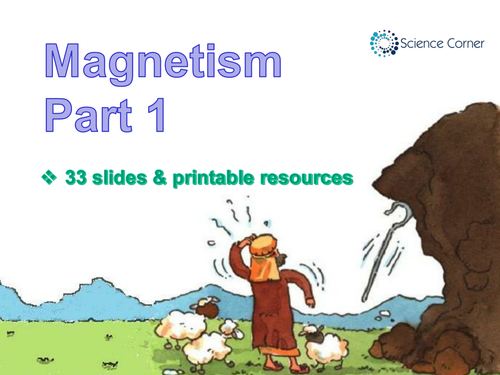








This resource pack includes 2 of my most popular resources on TES: Magnetism Parts 1 and 2
A total of 61 interactive and and visually appealing slides are included to help Year 7 or Year 8 pupils learn and understand magnetism. Scaffolded note-taking worksheets for pupils have been customized to be used during the series of lessons. Additional worksheets and assessments are also included. The learning objectives are listed below.
By the end of these lessons, learners will:
1) be introduced to the discovery and history of magnets
2) know the elements that have magnetic properties
3) observe how magnets attract or repel each other and attract some materials and not others
4) compare and group together a variety of everyday materials on the basis of whether they are attracted to a magnet, and identify some magnetic materials
5) describe magnets as having 2 poles
6) predict whether 2 magnets will attract or repel each other, depending on which poles are facing
7) know that materials contain groups of spinning electrons called domains
8) know that the domains are aligned in magnetic materials
9) know that the domains of a non-magnetic material are not aligned
10) learn about magnetic fields by plotting with compass, representation by field lines
11) learn about Earth’s magnetism, compass and navigation
12) explore the magnetic fields of permanent and induced magnets, and the Earth’s magnetic field
13) discover that a magnet can be made by stroking a steel bar with the same pole of a permanent magnet from one end to the other end in one direction
14) be able magnetise a needle and use it as a simple compass.
15) discover that when electric current flows through an insulated wire wound around an iron core, the core becomes a magnet
16) be able to build a simple electromagnet
17) explore ways to manipulate a variety of variables to increase the strength of the electromagnet
18) know some uses of electromagnets
19) distinguish between a permanent magnet and an electromagnet
20) learn the components of an electric bell and how an electric bell works
Please rate and comment. Cheers.
A total of 61 interactive and and visually appealing slides are included to help Year 7 or Year 8 pupils learn and understand magnetism. Scaffolded note-taking worksheets for pupils have been customized to be used during the series of lessons. Additional worksheets and assessments are also included. The learning objectives are listed below.
By the end of these lessons, learners will:
1) be introduced to the discovery and history of magnets
2) know the elements that have magnetic properties
3) observe how magnets attract or repel each other and attract some materials and not others
4) compare and group together a variety of everyday materials on the basis of whether they are attracted to a magnet, and identify some magnetic materials
5) describe magnets as having 2 poles
6) predict whether 2 magnets will attract or repel each other, depending on which poles are facing
7) know that materials contain groups of spinning electrons called domains
8) know that the domains are aligned in magnetic materials
9) know that the domains of a non-magnetic material are not aligned
10) learn about magnetic fields by plotting with compass, representation by field lines
11) learn about Earth’s magnetism, compass and navigation
12) explore the magnetic fields of permanent and induced magnets, and the Earth’s magnetic field
13) discover that a magnet can be made by stroking a steel bar with the same pole of a permanent magnet from one end to the other end in one direction
14) be able magnetise a needle and use it as a simple compass.
15) discover that when electric current flows through an insulated wire wound around an iron core, the core becomes a magnet
16) be able to build a simple electromagnet
17) explore ways to manipulate a variety of variables to increase the strength of the electromagnet
18) know some uses of electromagnets
19) distinguish between a permanent magnet and an electromagnet
20) learn the components of an electric bell and how an electric bell works
Please rate and comment. Cheers.
Something went wrong, please try again later.
This resource hasn't been reviewed yet
To ensure quality for our reviews, only customers who have purchased this resource can review it
Report this resourceto let us know if it violates our terms and conditions.
Our customer service team will review your report and will be in touch.
£5.00